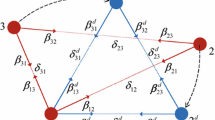Abstract
This paper analyzes how performance of a basic teleoperation task are influenced by the viewpoint of the video feedback, using a remote mobile robot. Specifically, the viewpoint is varied in terms of height and tilt and the influence on a basic task, such as following some pre-defined paths, is analyzed. The operators are able to control one motor degree of freedom and up to two perceptive degrees of freedom. It is shown that performance vary depending both on the viewpoint and on the amount of perceptive freedom; in particular, the chosen metrics give better results when more perspective and, surprisingly, a more constrained perception is deployed. Furthermore, the contrast between the actual performance and the performance perceived by the operators is shown, which allows to discuss about the need of quantitative approaches in measuring the efficiency of a teleoperation task.
Preview
Unable to display preview. Download preview PDF.
Similar content being viewed by others
References
Biocca, F.A., Rolland, J.P.: Virtual eyes can rearrange your body: adaptation to visual displacement in see-trough HMD. Presence 7(3) (1998)
Chow, Y., et al.: The effects of head-mounted display attributes on human visual perception of region warping distortions. In: Proc. of IVCNZ (2005)
Casals, A., Muiioz, L., Amat, J.: Workspace deformation based teleoperation for the increase of movement precision. In: IEEE ICRA (2003)
Waller, D., Hunt, E., Knapp, D.: The transfer of spatial knowledge in virtual environment training. Presence 7(2), 129–143 (1998)
Fiala, M.: Pano-presence for teleoperation. In: Proc. of IROS (2005)
Lewis, M., et al.: Experiments with attitude: attitude displays for teleoperation. In: Proc. IEEE Int. Conf. on Systems, Man, and Cybernetics (2003)
Livatino, S., Privitera, F.: 3d environment cognition in stereoscopic robot teleguide. In: Int. Conf. Spatial Cognition (2006)
Nielsen, C.W.: Ecological interfaces for improving mobile robot teleoperation. IEEE transaction on robotics 23 (2007)
Pfautz, J.D.: Distortion of depth perception in a virtual environment application. PhD thesis (1996)
Ryu, J., et al.: Influence of resolution degradation on distance estimation in virtual space displaying static and dynamic image. In: IEEE I.C. on Cyberworlds (2005)
Sheridan: Defining our terms. Presence 1(2), 272–274 (1992)
Siegel, M., Nagata, S.: Just enough reality: Comfortable 3-d viewing via microstereopsis. IEEE Trans. Circ. and Sys. for Video Tec. (2000)
Thropp, J.E., Chen, J.Y.C.: The effects of slow frame rates on human performance. U.S. Army Research Laboratory Technical report (2006)
Author information
Authors and Affiliations
Editor information
Editors and Affiliations
Rights and permissions
Copyright information
© 2009 Springer-Verlag Berlin Heidelberg
About this paper
Cite this paper
Brayda, L., Ortiz, J., Mollet, N., Chellali, R., Fontaine, JG. (2009). Quantitative and Qualitative Evaluation of Vision-Based Teleoperation of a Mobile Robot. In: Xie, M., Xiong, Y., Xiong, C., Liu, H., Hu, Z. (eds) Intelligent Robotics and Applications. ICIRA 2009. Lecture Notes in Computer Science(), vol 5928. Springer, Berlin, Heidelberg. https://doi.org/10.1007/978-3-642-10817-4_78
Download citation
DOI: https://doi.org/10.1007/978-3-642-10817-4_78
Publisher Name: Springer, Berlin, Heidelberg
Print ISBN: 978-3-642-10816-7
Online ISBN: 978-3-642-10817-4
eBook Packages: Computer ScienceComputer Science (R0)




